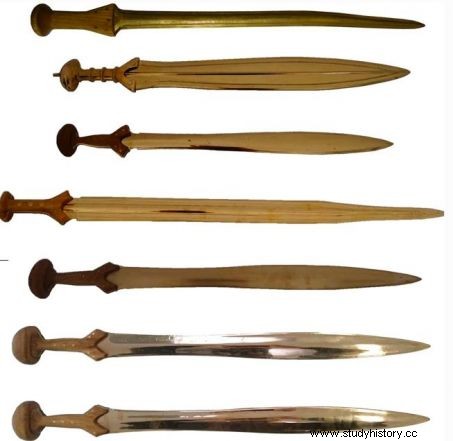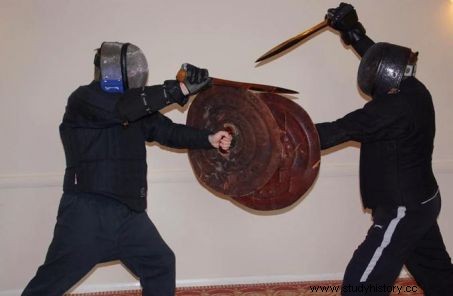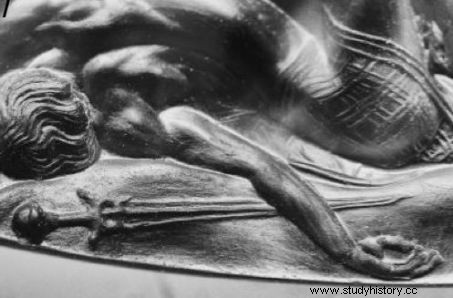A study reveals that the swords found in European Bronze Age tombs and metal deposits had not only a ceremonial function, but that they had all been used in combat.

Bronze Age Sword Set
Discovered in 2015 in a tomb at the Minoan site of Pylos, in Greece, a 3,500-year-old seal now considered a masterpiece, shows, engraved in agate, two warriors engaged in a fight to the death... The victor plunges his sword into an adversary's throat, while on the ground lies a first victim, his weapon fallen along his arm. This exceptional combat scene illustrates recent research carried out on Bronze Age swords, in order to better understand their use and, more broadly, the place of interpersonal violence and warfare in Europe during the Bronze Age.

Agate battle scene from the Tomb of the Griffin Warrior, Pylos, (Greece). Credits:Courtesy University of Cincinnati
Because what do we know about these weapons found by the thousands across Europe, in graves or metal deposits from the end of the 17th century before our era? What is the precise composition of the metal alloys they are made of? And how were they manipulated?
To answer these questions, researchers at the University of Newcastle (United Kingdom) examined thousands of marks and microtraces found on swords from this period under a microscope. They also carried out fights using replicas. The results are clear:all Bronze Age swords served well in battle. They were therefore not reserved for ceremonial or symbolic uses as had long been assumed.
Forging New Blades
In an article published in the Journal of Archaeological Method and Theory, Andrea Dolfini, director of the Bronze Age Combat Project (BACP), explains how his team of researchers from the universities of Leicester and Durham, the British Museum and Great North Hancock (England) first had Neil Burridge reproduce, a bronze craftsman, seven bronze swords corresponding to types well known by archaeology. These weapons were then used in experiments aimed at recording the different marks produced by blows struck blade against blade, against shields or spears.
Discovered in 2015 in a tomb at the Minoan site of Pylos, in Greece, a 3,500-year-old seal now considered a masterpiece, shows, engraved in agate, two warriors engaged in a fight to the death... The victor plunges his sword into an adversary's throat, while on the ground lies a first victim, his weapon fallen along his arm. This exceptional combat scene illustrates recent research carried out on Bronze Age swords, in order to better understand their use and, more broadly, the place of interpersonal violence and warfare in Europe during the Bronze Age.

Agate battle scene from the Tomb of the Griffin Warrior, Pylos, (Greece). Credits:Courtesy University of Cincinnati
Because what do we know about these weapons found by the thousands across Europe, in graves or metal deposits from the end of the 17 e ? century BCE? What is the precise composition of the metal alloys they are made of? And how were they manipulated?
To answer these questions, researchers at the University of Newcastle (United Kingdom) examined thousands of marks and microtraces found on swords from this period under a microscope. They also carried out fights using replicas. The results are clear:all Bronze Age swords served well in battle. They were therefore not reserved for ceremonial or symbolic uses as had long been assumed.
Forging New Blades
In an article published in the Journal of Archaeological Method and Theory, Andrea Dolfini, director of the Bronze Age Combat Project (BACP), explains how his team of researchers from the universities of Leicester and Durham, the British Museum and Great North Hancock (England) first had Neil Burridge reproduce, a bronze craftsman, seven bronze swords corresponding to types well known by archaeology. These weapons were then used in the context of experiments intended to record the different marks produced by blows struck blade against blade, against shields or spears.

Replicas of Bronze Age swords made by bronze craftsman Neil Burridge. Credits:BACP
To do this, the scientific team collaborated with members of the Hotspur School of Defense , a medieval European fighting club in Newcastle (UK), in order, based on a 15th century fencing manual - "The sword &buckler of master Andreas Liegnitzer" - to stage sequences of realistic confrontations, such as they could have taken place in the Bronze Age.

Experimental confrontation sequence for impact analysis. Credits:Hotspur School of Defense
Thus, by combining experimental archeology and metal wear analyses, the traces found on the duplicated weapons were compared to 2,500 others found on 110 original swords dated from the end of the 2nd millennium to the beginning of the 1 st millennium BC:70 preserved in Britain and another 40 in Italy. "These traces made it possible to link combat actions, types of physical engagements to specific wear marks on weapons, especially in strikes and parries" , said Raphaël Hermann, today at the University of Göttingen (Germany), co-signer of the article.
The sword, the first object created to kill
"In the history of mankind, swords were the first objects invented solely to injure or kill! They thus constitute a chronological marker, a technical milestone in the evolution of armament" , recalls the archaeologist Anne Lehoërff, specialist in European Protohistory, author of By Arms. The Day Man Invented War * , which does not participate in this work.

Detail of the engraving of the vanquished warrior of the agate of Pylos. Credits:Courtesy Department of Classical Studies, University of Cincinnati
"For swords made of bronze, copper alloy and tin to be functional, they had to have a tin content of at least 8% and a maximum of 11-12%. They were not productions standardized, but the work of bronze craftsmen who appeared at the end of the 3rd millennium BC with the birth of the metallurgy of copper alloys.There was therefore no standard alloy, and these compositions could vary in considerable proportions according to technological, aesthetic or economic criteria “, continues the specialist interviewed by Sciences et Avenir . The comparative study of impact and wear marks on the replicas and the originals has above all demonstrated that the warriors of the Bronze Age did not wield the sword haphazardly but had real fighting techniques, such as the had pointed out the pioneering work of Bénédicte Quilliec, of the National Institute for Preventive Archaeological Research (Inrap).
"The stigmata on the blades tell us about how these weapons were held, handled and used in battle", confirms Anne Lehoërff. By plunging his sword into the upper part of his enemy's body, the warrior of Pylos provides information on how these clashes unfolded, the blows targeting the soft parts of the bodies. The wounds inflicted by these extremely effective weapons have been confirmed by numerous osteological analyses, which these new impact studies thus complete.
*By arms. The Day Man Invented War * , Anne Lehoërff, Belin, 2018.
